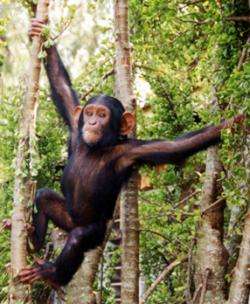Scientists narrow time limits for human, chimp split

A team of researchers has proposed new limits on the time when the most recent common ancestor of humans and their closest ape relatives – the chimpanzees – lived. Scientists at Arizona State University and Penn State University have placed the time of this split between 5 and 7 million years ago – a sharper focus than that given by the previous collection of molecular and fossil studies, which have placed the divergence anywhere from 3 to 13 million years ago.
Image: Our closest animal relative is not so far away. Chimpanzees diverged from humans only 5-7 million years ago according to a newly released study of gene sequences. Credit: Anne Fischer, Max Plank-Institute for Evolutionary Anthropology
The scientists analyzed the largest data set yet of genes that code for proteins and also used an improved computational approach that they developed, which takes into account more of the variability – or statistical error – in the data than any other previous study.
Gene studies are needed to address this problem because the interpretation of the earliest fossils of humans at the ape/human boundary are controversial and because almost no fossils of chimpanzees have been discovered.
"No study before has taken into account all of the error involved in estimating time with the molecular-clock method," says Sudhir Kumar, lead author on the report, which was published online in the journal, Proceedings of the National Academy of Sciences. The team describes its new statistical technique as a "multifactor bootstrap-resampling approach."
"There is considerable interest in knowing when we diverged from our closest relative among animal species," says Kumar, who is director of the Center for Evolutionary Functional Genomics in the Biodesign Institute at Arizona State University. "This divergence time also has considerable importance because it is used to establish how fast genes mutate in humans and to date the historical spread of our species around the globe." Kumar was assisted at ASU by research associate Alan Filipski and graduate student Vinod Swarna.
Penn State evolutionary biologists Alan Walker and Blair Hedges also took part in the collaborative effort. The team examined 167 different gene sequence sets from humans, chimpanzees, macaques and mice.
"In order to reduce the variability in this time estimate as much as possible, we needed the largest amount of data available," says Kumar.
The scientists estimated the time of divergence between species by studying the sequential arrangement of nucleotides that make up the chain-like DNA molecules of each species. The number of mutations in the DNA sequence of a species, compared with other species, is a gauge of its rate of evolutionary change. By calibrating this rate with the known time of divergence of a species on another branch of the tree-like diagram that shows relationships among species, scientists can estimate the time when the species they are studying evolved. In this case, the calibration time the scientists used was the split of Old World monkeys – including baboons, macaques, and others – from the branch of the phylogenetic tree that led to humans and apes, which fossil studies have shown is at least 24 million years ago. Using this calibration time, the team estimated that the human-chimp divergence occurred at least 5 million years ago, proportionally about one-fifth of the calibration time.
This time is consistent with the findings of several research groups that have used the molecular-clock method to estimate the split of humans and chimpanzees since the first attempt in 1967. But this is only a minimum estimate, because it was based on a minimum calibration time. To obtain a maximum limit on the human-chimp divergence, the team used as a calibration point the maximum estimate, based on fossil studies, of the divergence of Old-World monkeys and the branch leading to humans – 35 million years ago.
Calculations using this date yielded a time for the human-chimp split of approximately 7 million years ago, which again was proportionally about one-fifth of the calibration time.
"We can conclude that humans and chimpanzees probably last shared a common ancestor between five and seven million years ago," says Blair Hedges, professor of biology at Penn State. "Although this conclusion does not exclude younger or older dates as being possible, it says they are less likely to be correct."
Hedges, who also is an astrobiologist, adds that "knowing the timescale of human evolution, and how we changed through time in relation to our environment, could provide valuable clues for understanding – in a more general sense – the evolution of intelligent life."
Walker, a paleoanthropologist and Evan Pugh Professor of Biological Anthropology and Biology at Penn State, has discovered and studied fossil hominids and other primate species that pertain to the question of the human-chimp divergence.
"While this research does not pinpoint the precise time of the split, it tells us that proportional differences on branches in family trees should be considered when proposing new times. For example, we now know that a 10-to-12-million-year human-chimp split would infer a divergence of Old World monkeys from our lineage that is too old (50-to-60-million years ago) to reconcile with the current fossil record of primates," says Walker.
What then is the next step? Although some additional improvement is possible by including more genes and more species, "the greatest opportunity now for further narrowing this estimate of 5-to-7-million years will be the discovery of new fossils and the improvement in geologic dating of existing fossils," says Walker.
Source: Arizona State University


















